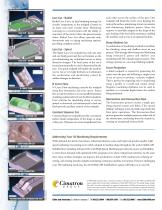
Catalog excerpts

GibbsCAM® SolidSurfacer® Including Advanced 3D with High-Speed Machining (HSM) POCKETING WITH CORE DETECTION GibbsCAM SolidSurfacer provides powerful capabilities for machining complex 3D solids, surfaces, and STL files with toolpaths tailored for high speed machining and hard-metal cutting. Smooth corners, smooth stepovers and arc fitting minimize sudden direction changes, improving surface finishes. Minimizing tool retracts and maintaining a constant tool load helps machine tools to run faster and reduce tool wear and breakage. Automatic gouge protection, tool holder collision checking, and rest material options make it easy to use short rigid tools and large efficient tools in combination to cut parts faster. HSM Rough Machining Capabilities Pocketing MATERIAL-ONLY ROUGHING HSM Finish Machining Capabilities Contour Pocketing clears large volumes of material efficiently. A series of offset or zig-zag passes are generated at constant Z-depths calculated to remove the maximum amount of material without leaving uncut areas. The depth of cut is adaptive, adding more cuts in shallow areas to improve consistency of scallop height. Helix or profile ramping entries are combined with smooth corner arcs and smooth transitions between passes, allowing for faster cycle times. For components with steep walls, the constant-Z slices provided by Contour leaves a good surface finish. Boundary geometry can be used to control the machining region and angle limits can be used to eliminate passes in shallow areas. A helical option allows one continuous path to be created eliminating witness lines on the part and improving surface finish. Pocketing with Core Detection CONTOUR Automatic core detection allows the Pocketing process to machine cores from the outside-in, starting from the outside of the material, and working in to the shape of the core. Processes that include both core and cavity areas automatically switch between core roughing and cavity roughing styles in a single process, saving programming time. Material-only Roughing FLATS CUT 3D material-only cutting is achieved by following the operation of a big tool with one or more smaller tools in areas not cleared by the previous operation. Finish part plus stock amount for castings, user supplied solids or STL files, or automatic rest material calculated from a prior process can all be used to avoid air-cutting and increase machine tool productivity. Flexible retract styles and options add to toolpath efficiency. Flats Cut The Flats Cut process automatically detects all the flat areas of the part clearing them with an offsetting path at the Z-level of each area. Using a flat bottom tool, helix and profile ramping entries, and smooth positioning motions between areas, machining time is reduced and surface finish improved. Any number of Z-axial offset passes can be added. Lace Cut – Raster For many parts, parallel plane cuts generated by the Lace Cut process are most effective. Unidirectional or zigzag passes can be set at any angle. Normal vector angles define steep and shallow areas eliminating the need for complex geometry boundaries. Optimized cross-machining can automatically create additional perpendicular passes, machining only the areas necessary to produce a constant surface finish. Z-steps can be used to rough and finish the part in one operation. Smooth stepovers and tangential path extensions produce a better surface finish and smoother running machine tool.
Open the catalog to page 1
Lace Cut - Radial Radial Lace Cut is an ideal finishing strategy for circular components as the toolpath is based on an inner and outer circular limit. Machining converges to a central point with the ability to stop short of the center where the passes become dense. Radial Lace Cut allows upwards only, downwards only or zigzag machining options, providing complete control. Lace Cut - Spiral The Spiral Lace Cut toolpath has only one start and one finish point and the tool remains on the part eliminating any redundant moves or sharp direction changes. The focal point of the cut is located...
Open the catalog to page 2Archived catalogs
-
GibbsCAM MTM
2 Pages
-
GibbsCAM® 12
2 Pages
-
SolidSurfacer
4 Pages
-
5-Axis MultiBlade
4 Pages
-
System Management Tombstone
2 Pages
-
stems Production G
6 Pages
-
GibbsCAM 13
2 Pages
-
Solar Energy
5 Pages
-
DHP 5000
2 Pages
-
TOMBSTONE MANAGEMENT SYSTEM
2 Pages
-
GibbsCAM 2015 Enhancements
4 Pages
-
Why GibbsCAM?
2 Pages
-
GibbsCAM 5-Axis
2 Pages
-
TOMBSTONE MANAGEMENT SYSTEM
2 Pages
-
CAD Interoperability
2 Pages
-
GibbsCAMWire-EDM
2 Pages
-
GibbsCAM® MTM
2 Pages
-
Gibbs Overview
2 Pages
































